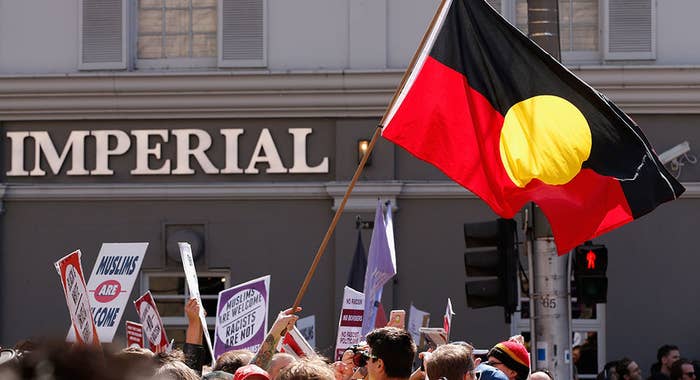
I am not only Asian and Aboriginal, but my chosen faith for the past 16 years has been Islam — it’s been said to me on a number of occasions that if I ever met Pauline Hanson, her head would explode.
Sometimes I laugh along, and quite often I tell this joke myself. But my fake smile always comes with an inner cringe — a flush of embarrassment that people find my cultural and religious blend an oddity.
I anticipate that they will stereotype me, and that I will have to deal with their racist comments again and again. It gives rise to the kind of cringe you might associate with being randomly picked on in public by a drunk person. It's embarrassing being the focus of such personal, negative attention, so publicly.
When Pauline Hanson first came to the political fore, I remember that first flush of embarrassment at having my personal identity publicly shamed.
As a young woman, just 14-years-old when Hanson gave her maiden speech in 1996, I proudly identified as both Aboriginal and Chinese, secure in the fact that it was a common cultural heritage in the land of my forebears, Australia’s Top End.
I was not immune to the environment around me, an environment that not only wanted “Asians out”, but also devalued the lives and culture of Aboriginal people. A hostile society that attempted to steal everything from Aboriginal people, only to turn around and typecast us as always having our hands out.
This stereotype of Aboriginal people – that they always have their hand out, never wanting to work for anything compared to the hard-working Australian – is long-entrenched in our society.
“Characterisation of Indigenous Australians as recipients of a ‘free ride’, and who are seen to be motivated to rort the public purse, has its roots in an ignorance of Indigenous experiences of dispossession, colonisation and ongoing colonial violence,’’ as professor Bronwyn Carlson writes, regarding the endurance of this stereotype.
I’d go a step further and say that this stereotype is a clear projection of guilt. White Australia has formed a narrative that Aboriginal people receive free benefits, so as to deflect and disown the reality of its own “free ride” on a land that did not then, and still does not now, belong to them.
Aboriginal and Torres Strait Islander people have never ceded their sovereignty, instead resisting colonisation through the Frontier Wars fought across the continent over a span of a century and half.
Since 1938 we have protested and mourned the denial of our sovereignty, and our subsequent racist mistreatment, every January 26.
Commemorating the arrival of the First Fleet, Australia Day is an implicit celebration of the British Empire’s fundamental racism, with the colonisation of the continent predicated on the superiority of the white race.
January 26 represents an injustice that has never been rectified, a founding racism that is woven in to our society and its institutions. It is a date that is forever tied to stolen land.
It is no wonder, then, that this founding act has morphed across the years, replicated now in the stereotype of the foreigner who is coming to swamp our country and change our way of life. In this way, the racism against First Nations people, and subsequently against non-Anglo-Celtic migrants, is shown to be two sides of the same coin. Such racism acts to suppress First Nations sovereignty and to protect White Australia’s borders from the threat of racial impurity and foreign invasion.
As a repeating pattern, this fear of an invading foreign people is a history that can be broadly painted across successive waves of migration.
Anti-Chinese sentiment during the Australian gold rush era, racism against Greek and Italian communities after World War II, and then Vietnamese and Cambodian migrants and refugees after the Vietnam War; Islamophobia and anti-Middle Eastern sentiment in the years after September 11; and, more recently, racist rhetoric against members of the African community.
Each group has faced Australia’s ugly racism, and to a large extent has been able to move beyond it, as the spotlight and vilification shifts to the next wave of immigrants. Not so for Australia’s First Nations people.
This only affirms the idea that at the very core of Australian racism is the ongoing dispossession of Aboriginal and Torres Strait Islander people.
The ability of White Australia to ultimately accept different groups of migrants is not a triumph of multiculturalism, rather it is based upon this core of dispossession. The multicultural narrative denies First Nations sovereignty, and re-centres White Australia as the default.
This default Australia is the Australia that we celebrate on January 26, commemorating the arrival of the First Fleet and the beginning of a brutal colonisation of the continent.
Inherently racist, the fact that colonisation gave rise to modern Australia should give us all pause for thought.
When we trace our history we can see that it is punctuated with waves of racism, coinciding with waves of migration and exposing the country’s true nature beyond the egalitarian façade we promote.
It's Australia Day, accompanied by the hiss of recent anti-African sentiment, and the enduring anti-Aboriginal sentiment bubbling to the surface once again.
Without restitution – a truth and healing process about colonisation, a treaty with First Nations people, the justice of land rights – we will forever remain stuck as a nation of racists.
